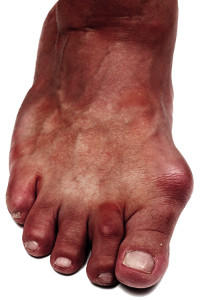 A foot condition that is referred to as a bunion is known as a bone disorder. It appears as a hard protrusion on the side of the big toe and may develop as a result of the bone structure that is out of alignment. The joint may begin to extend abnormally, and this may be caused by the second toe pushing against the big toe. There may be several reasons why people develop bunions, and these may include an injury that has occurred to the foot, different types of arthritis, low arches, or inherited traits. The symptoms that many patients experience may be a burning sensation, swelling on or around the afflicted joint, redness, or discomfort. Despite the fact that research has shown how wearing shoes that fit incorrectly do not cause bunions, the symptoms may be severely uncomfortable as a result of this. If you feel you have developed a bunion, it’s advised to seek the counsel of a podiatrist to discuss what treatments options are available for you.
A foot condition that is referred to as a bunion is known as a bone disorder. It appears as a hard protrusion on the side of the big toe and may develop as a result of the bone structure that is out of alignment. The joint may begin to extend abnormally, and this may be caused by the second toe pushing against the big toe. There may be several reasons why people develop bunions, and these may include an injury that has occurred to the foot, different types of arthritis, low arches, or inherited traits. The symptoms that many patients experience may be a burning sensation, swelling on or around the afflicted joint, redness, or discomfort. Despite the fact that research has shown how wearing shoes that fit incorrectly do not cause bunions, the symptoms may be severely uncomfortable as a result of this. If you feel you have developed a bunion, it’s advised to seek the counsel of a podiatrist to discuss what treatments options are available for you.
If you are suffering from bunion pain, contact one of our podiatrists of Family Foot Care of Long Island. Our doctors can provide the care you need to keep you pain-free and on your feet.
What Is a Bunion?
Bunions are painful bony bumps that usually develop on the inside of the foot at the joint of the big toe. As the deformity increases over time, it may become painful to walk and wear shoes. Women are more likely to exacerbate existing bunions since they often wear tight, narrow shoes that shift their toes together. Bunion pain can be relieved by wearing wider shoes with enough room for the toes.
Causes
- Genetics – some people inherit feet that are more prone to bunion development
- Inflammatory Conditions - rheumatoid arthritis and polio may cause bunion development
Symptoms
- Redness and inflammation
- Pain and tenderness
- Callus or corns on the bump
- Restricted motion in the big toe
In order to diagnose your bunion, your podiatrist may ask about your medical history, symptoms, and general health. Your doctor might also order an x-ray to take a closer look at your feet. Nonsurgical treatment options include orthotics, padding, icing, changes in footwear, and medication. If nonsurgical treatments don’t alleviate your bunion pain, surgery may be necessary.
If you have any questions, please feel free to contact our office located in Port Jefferson Station, NY . We offer the newest diagnostic and treatment technologies for all your foot care needs.
Read more about What Are Bunions?